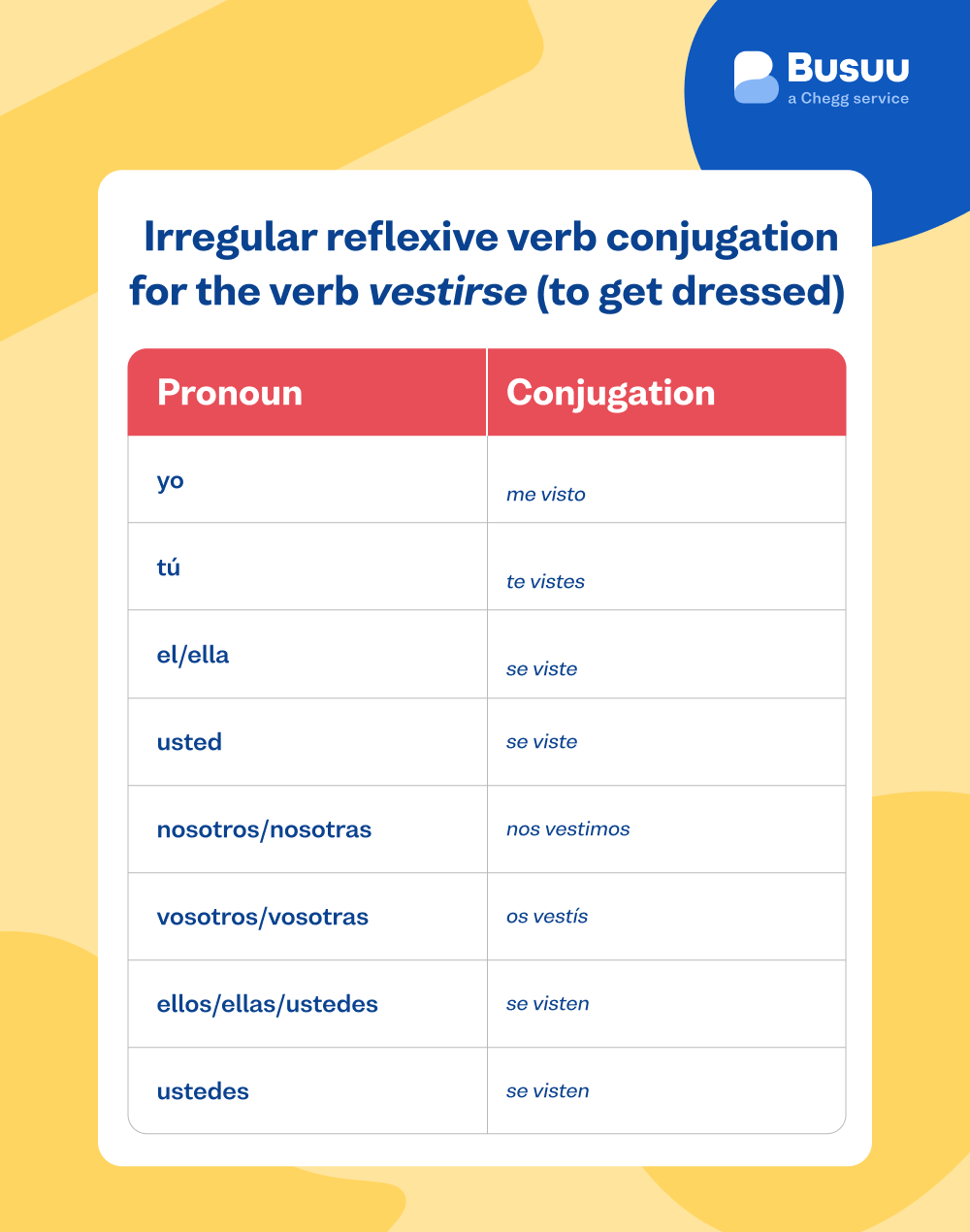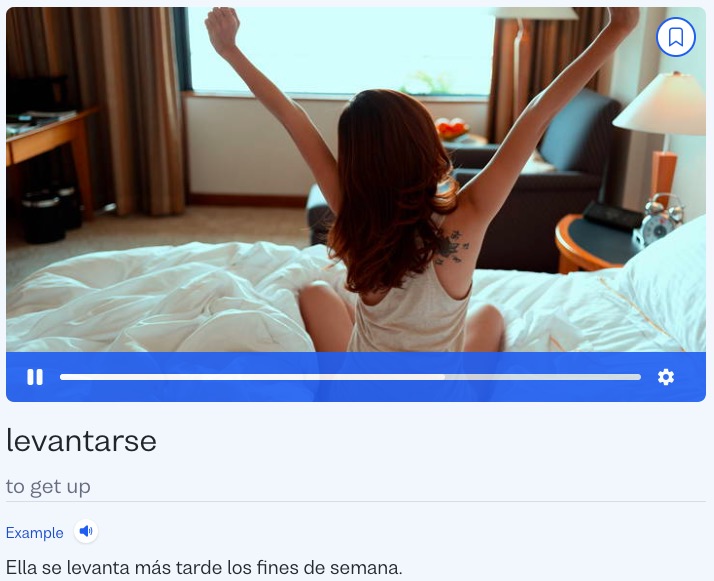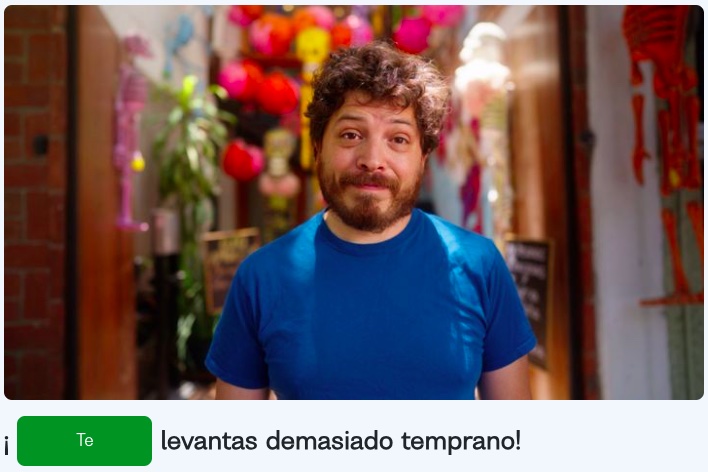Reflexive Verbs in Spanish
Master the basics of reflexive verbs in Spanish
I want to learn...
What do waking up, brushing your teeth, and getting dressed all have in common? Well, other than they are likely part of your morning routine, they are all reflexive verbs in Spanish.
Reflexive verbs are essentially verbs where someone or something performs the action of the verb on itself/themself.
In this article, we’ll cover the basics of reflexive verbs, including how they work with reflexive pronouns, how they are conjugated, and when to use them.
¡Empecemos!
Let’s begin!
Spanish reflexive verbs
Reflexive verbs are interesting in that they show that the subject of the sentence is also the object. They are often used to talk about routines, self-care, and emotions (having fun, feeling something).
Take a look at these reflexive verbs:
- levantarse (to wake up)
- lavarse (to wash oneself)
- peinarse (to comb one’s hair)
- acostarse (to go to bed)
- vestirse (to get dressed)
Besides the fact that they all have to do with self-care and daily routines, they all end with -se, a reflexive pronoun. As we’ll see in a second, reflexive pronouns play a huge role in the sentence structure and conjugation of reflexive verbs.
But before we dive into the sentence structure and conjugation of reflexive verbs, let’s review reflexive pronouns.
Spanish reflexive pronouns
| Singular | Plural | ||
|---|---|---|---|
| me | myself | nos | ourselves |
| te | yourself | os | yourselves |
| se | himself/herself/yourself (formal) | se | themselves/yourselves (formal) |
Note: The reflexive pronoun “os” matches with the personal pronoun vosotros / vosotras and is mostly used in Spain.
Reflexive pronouns show that the action of the verb reflects back onto the subject. They are used with reflexive verbs and must agree with the subject in number (singular or plural) and person (first, second, or third).
To get a better idea of what this means, take a look at this example:
Yo me lavo las manos. (I wash my hands)
Here we can see that the reflexive pronoun me agrees with the subject yo.
Take a look at another example:
Nos peinamos antes de salir. (We comb our hair before going out.)
Same thing here—the reflexive pronoun nos agrees with the subject nosotros/nosotras. Even though the pronoun nosotros/nosotras has been omitted in this sentence, it is implied by the conjugation of peinamos.
Now that we’ve reviewed reflexive pronouns and seen some examples, let’s break down the sentence structure and conjugation rules for reflexive verbs.
Spanish reflexive verbs: Conjugation and sentence structure
Before we start conjugating reflexive verbs, it’s important to understand the sentence structure in which they are employed. The sentence structure for reflexive verbs is as follows:
subject + reflexive pronoun + conjugated verb + rest of the sentence
Here are the steps to conjugate Spanish reflexive verbs:
- Identify the reflexive pronoun that agrees with the subject (me, te, se, nos, os, se).
- Remove the -se ending from the infinitive form of the verb.
- Conjugate the verb, matching the subject with the appropriate verb ending.
- Place the reflexive pronoun before the verb.
To conjugate the present tense of a regular verb like levantarse, this would look like this:
Él se levanta temprano. (He wakes up early.)
Looking at this example, you can see the reflexive pronoun is placed before the verb and the verb is conjugated with its corresponding ending in the present tense.
Knowing this, how would you say, “I wake up early”?
Hint: Remember to use the correct reflexive pronoun and that the pronoun and the verb need to match.
If you came up with this:
Yo me levanto temprano. (I wake up early.)
You are correct! Nice job. This sentence follows the right structure, conjugation, and agreement rules of sentences with reflexive verbs.
Yo (subject) + me (reflexive pronoun) + levanto (conjugated verb) + temprano (rest of the sentence).
Pro Tip: If you need to brush up on your regular verb conjugations to make this easier, you can do so by checking out our article on regular verbs.
Let’s look at a couple more examples:
¿Os peináis con cepillo o con peine? (Do you comb your hair with a brush or a comb?)
Él se levanta a las seis de la mañana. (He wakes up at six in the morning.)
¿A qué hora te acuestas normalmente? (What time do you usually go to bed.)
As we touched on a bit before, these sentences don’t always include the personal pronoun (yo, tú, él, nosotros, etc.). This is because, in Spanish, it is quite common to drop the personal pronoun in sentences where the subject is already made clear by the context.
In the case of reflexive sentences, the reflexive pronouns and the conjugation of the verbs often already make the subject clear.
If it isn’t clear, you should make sure that you include the personal pronoun to avoid confusing the listener.
Now that you’re feeling pretty confident with regular Spanish reflexive verbs, let’s take a look at some irregular verbs.
Irregular Spanish reflexive verbs
With any grammar point in Spanish, there are always irregular verbs to consider—and reflexive verbs are no exception.
Irregular reflexive verbs in Spanish don’t follow the normal conjugation patterns of regular verbs and may have unique forms in certain tenses or with certain pronouns.
Essentially, they may have different endings or stem changes when compared to regular verbs.
Let’s look at a verb from our list at the beginning of this article: vestirse (to get dressed) as an example of an irregular verb. Note that the stem of the verb changes with all pronouns except nosotros/nosotras and vosotros/vosotras.

Irregular reflexive verb: Vestirse (to get dressed)
| Pronoun | Conjugation |
|---|---|
| yo | me visto |
| tú | te vistes |
| el/ella | se viste |
| usted | se viste |
| nosotros/nosotras | nos vestimos |
| vosotros/vosotras | os vestís |
| ellos/ellas | se visten |
| ustedes | se visten |
Vestirse doesn’t follow the conjugation patterns of regular verbs, and we must take that into consideration when using it (just like with any irregular verb).
Here are a couple of sentences using vestirse:
Yo me visto con ropa elegante para una fiesta. (I get dressed in elegant clothes for a party.)
Nosotros nos vestimos con ropa cómoda para ir de excursión. (We get dressed in comfortable clothes to go on a hike.)
Here is a list of commonly used irregular reflexive verbs to keep in mind:
- irse - to leave
- dormirse - to fall asleep
- despertarse - to wake up
- ponerse - “to put on" or "to wear" when referring to clothing
- divertirse - to have fun
- sentirse - to feel
It’s important to know the irregular conjugation patterns of these and other irregular verbs. Unfortunately, because they don’t follow regular conjugation patterns, you’ll need to memorize them.
But don’t worry—with enough practice you’ll be using them quickly and easily in no time.
Reflexive verbs: A change in meaning
Many Spanish verbs change in meaning when they are used with reflexive pronouns. For example, dormir, which means “to sleep”, becomes “to fall asleep” in its reflexive form dormirse.
Some other verbs include:
-
Lavar (to wash) vs. lavarse (to wash oneself)
-
Lavo el coche. (I wash the car.)
-
Tú te lavas las manos. (You wash your hands)
-
Poner (to put) vs. ponerse (to put on)
-
Ellos ponen los libros en la mesa. (They put the books on the table.)
-
Juan se pone el abrigo. (Juan puts on the coat.)
-
Ir (to go) vs. irse (to leave)
-
Voy al parque. (I go to the park.)
-
Me voy de la fiesta. (I'm leaving the party.)
-
Quitar (to remove) vs. quitarse (to take off)
-
Vosotros quitáis el polvo de los muebles. (You [plural] remove the dust from the furniture.)
-
Me quito los zapatos. (I take off my shoes.)
As you may have noticed from the examples, when we use a verb with a reflexive pronoun, its meaning often becomes more focused on the subject performing the action.
Reflexive verbs in Spanish: Recap
We now know that reflexive verbs are verbs that show the subject of the sentence is also the object, that something or someone performs the action on itself / themself.
We also know that to use a reflexive verb correctly, we place the reflexive pronoun before the verb (making sure it agrees with the subject) and conjugate the verb as we normally would.
Remember: subject + reflexive pronoun + conjugated verb + rest of the sentence
Reflexive verbs are used in many situations in Spanish, often to talk about routines, self-care, or feelings/emotions.
Now that you know the basics, you’re all set to start using them in your own Spanish practice.
¡Buena suerte!
Good luck!
Don’t stop now…keep the learning streak going!
Practice makes perfect, and Busuu offers free Spanish lessons using online learning resources designed by language experts. Continue practising and be well on your way to Spanish fluency in no time!

